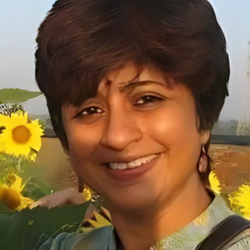Inter-Lingual Theatre Circuits and Caste Contestations in the Bombay Deccan (1840s–1930s) Veena Naregal (Institute of Economic Growth, Delhi)

When:
Tuesday, April 15, 2025
12:00 PM - 1:30 PM CT
Where: Kresge Hall, 4438, 1880 Campus Drive, Evanston, IL 60208 map it
Audience: Faculty/Staff - Student
Contact:
Cindy Pingry
(847) 467-1933
c-pingry@northwestern.edu
Group: South Asia Research Forum
Category: Academic
Description:
Abstract:
The intertwined histories of Marathi and Kannada professional theatre (1840s–1930s) in the Deccan reveal theatre as a crucial space for redefining cultural authority, linguistic identity, and social power within a caste-segmented, polyglot society shaped by print. Often overlooked as an archive, theatre history highlights South Asia's inter-lingual fluidity, with itinerant troupes bridging urban and rural audiences, print and oral traditions, and elite and subaltern aesthetics. Beginning in the 1840s, Marathi itinerant natak mandalis—typically family-run, upper-caste troupes owned by Brahmin families—offered a platform for intellectuals to showcase their learning, textual knowledge, and musical mastery, creating new social and economic opportunities. For the Marathi sphere, these troupes institutionalized “bookish” natak as a high cultural theatrical form, sidelining pauranik khel and farce, while appropriating lower-caste oral traditions to align Marathi theatre with the emerging elite cultural agenda. Meanwhile, in Pune, ‘Deputy’ Chennabasappa's engagement with radical intellectuals and colonial education officials influenced his efforts to shape Kannada linguistic modernity, paving the way for early Kannada playwrights like Shantakavi and Churmuri Sheshagiri Rao. Despite these intersections, regional differences defined the trajectories of Marathi and Kannada theatre. By the early 20th century, Marathi theatre became emblematic of middle-class Marathi identity, while Kannada theatre—developing across Belgaum, Dharwad, Bijapur (Bombay Presidency), and Bellary (Madras Presidency)—sought to challenge Marathi dominance, even as caste and intra-community struggles shaped Kannada theatre’s role in linguistic nationalism. Through an analysis of play texts, genres, theatre biographies, memoirs, and theatre journals, I show how debates on theatrical modernity—especially concerning music, “realism,” and women’s presence onstage—were closely intertwined with caste and class identities. These debates, in turn, were shaped by efforts at cultural marginalization, with upper-caste norms redefining the criteria for aesthetic enjoyment and pleasure in both linguistic contexts.
Veena Naregal is Professor of Sociology at the Institute of Economic Growth, Delhi. With training in Literature, Political Studies, and History, her research focuses on marginalization across discursive, institutional, and cultural fields. Specifically, she examines the negotiation of cultural and political authority in India's intensely polyglot, hierarchically segmented society. Her work on the politics of language, print, and performance has led to a collaborative project compiling three volumes of translated primary materials on the social history of regional theatres in Marathi, Kannada, and Tamil.
Current research themes include the history of modern economic thought in Asia, through Marathi translations of political economy texts in colonial Mumbai; the intersection of linguistic territorialization and developmental agendas between 1920 and 1960; and continuities in India's social policy, particularly regarding education, labor market dualism, and informality. Since COVID-19, she has expanded her work to include digital governance and welfare frameworks in post-pandemic India. Professor Naregal has taught at the University of Texas at Austin and held several fellowships in India and abroad.